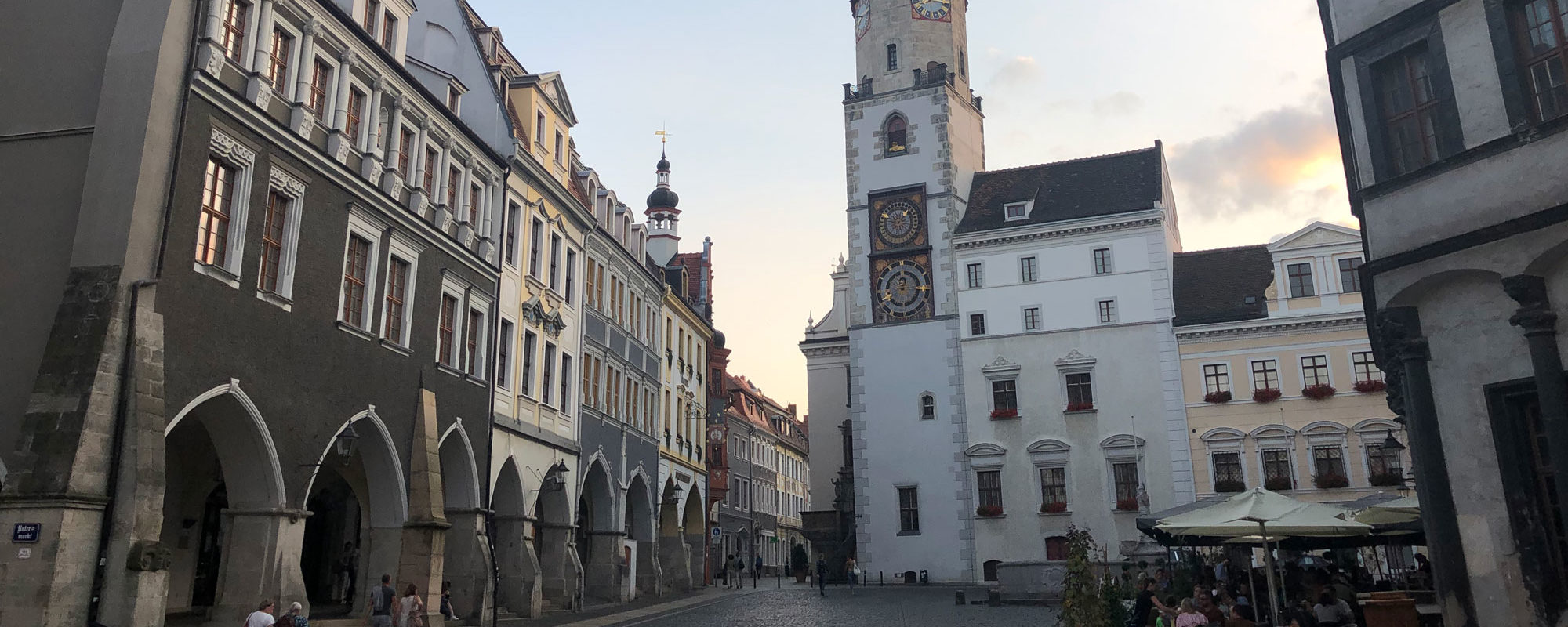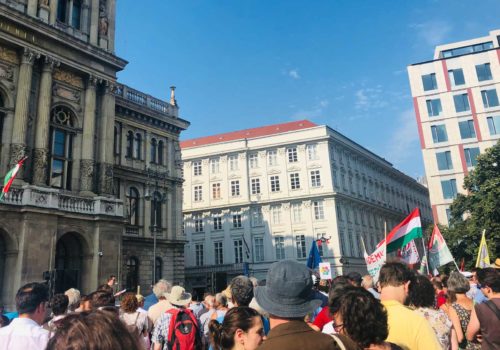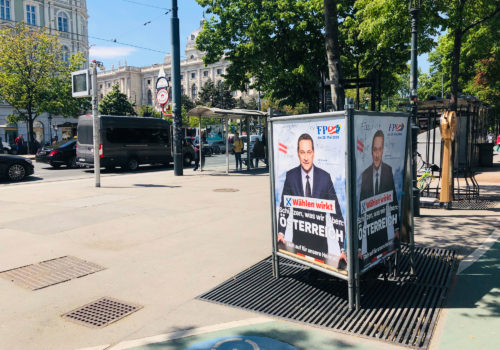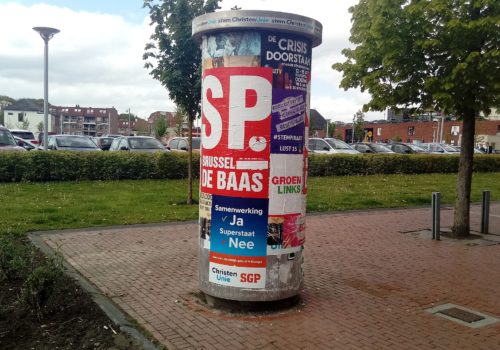GÖRLITZ, Germany — Walking along the Neiße River in this country’s easternmost city, in the state of Saxony, it’s hard to believe Poland lies just a few hundred meters away. There are no border checkpoints or controls; the only real indication that one is standing at the crossroads of two countries is a series of cement markers along each riverbank (red, black and gold on the German side, red and white on the Polish—like the countries’ respective flags). Indeed, the two sides were one unified city until 1945, when the Allies drew new post-World War II borders along the Neiße straight through the city.
The first time I strolled across the pedestrian bridge from Görlitz’s old town to Zgorzelec, its Polish counterpart, it occurred to me as I was halfway across that I hadn’t even thought to bring my passport—or take out Polish złoty to pay with when I arrived. (Neither was a problem.) Sometimes my phone gets confused as to which country it’s in, sending me “Willkommen in Polen” messages even when my feet are still firmly on the German side (or continuing to pick up Germany’s Vodafone network while I’m wandering the streets of Zgorzelec).
Walking back from Zgorzelec into Germany at the end of my first week here, I saw two men erecting a large silver tower on the German edge of the pedestrian bridge. On the tower were several video surveillance cameras, installed by the city to help observe instances of Grenzkriminalität, or cross-border crimes. Whether focused on such crimes or the city’s relatively low refugee and migrant population, security has been the leading topic of political discussion here in recent years—the primary issue of the populist far-right Alternative for Germany party (AfD).
As a border town, Görlitz is inherently international: Poles make up the majority of the approximately 6,000 foreign residents here, and many people live on one side of the border and work on the other. A third border, with the Czech Republic, lies approximately 20 miles to the south. Since Poland joined the European Union in 2004 and the border-free Schengen travel zone in 2007, Görlitz-Zgorzelec have served as a sort of model, modern European city with fluid borders allowing for free movement, exchange of people and cultures, and so on.
What’s more, with its beautifully restored old town, Görlitz has attained a level of international acclaim as “Görliwood,” a filming location for such Hollywood movies as “The Grand Budapest Hotel” and “Inglourious Basterds.” (Indeed, the city has lived up to its reputation during my time here: The day I arrived, in late July, a German film crew started shooting a movie adaptation of Erich Kästner’s Fabian; on occasion, I ran into their trucks around town.)
But the old town bridge between countries and its new video surveillance tower felt to me like a symbol of the contradictions I’ve discovered since arriving in Görlitz: open versus closed-off, welcoming versus insular. If the city is as open and international as it seems at first glance, how did 45 percent of its population vote for Sebastian Wippel, an AfD mayoral candidate who campaigned on reintroducing border controls with Zgorzelec?
That question—the particular strength of the AfD in Görlitz, and in eastern Germany more broadly—is a big part of why I came to live here for a month. Saxony will hold state elections on Sept. 1 along with Brandenburg, both strongholds for the AfD. May’s European elections showed a sharp east-west divide in support for the party; here in eastern Germany, its strength has only solidified. What is it about Görlitz, and the region more broadly, that’s led the far-right party to such success?
“If you look at the political landscape of Germany or Saxony, it’s no longer a game of left or right—it’s a question between openness and being a closed society,” Franziska Schubert, the mayoral candidate from the Greens who’s now her party’s main state election candidate in Görlitz, told me. “It’s a question of liberality and openness to the world, or closed, being closed-off. This is the new range in which the arena is drawn.”

Home to about 57,000 people, Görlitz has a history spanning centuries and empires: Over the years, it’s changed hands from the Habsburgs to Prussia to Saxony today. In its historic old town, colorful, carefully maintained buildings stand as a physical reminder of the city’s position along the Via Regia, one of Europe’s historic main trading roads. When I first arrived, it was immediately clear why so many film crews come here: the old town looks and feels like the perfect example of a quaint German city.
In some ways, it’s a minor miracle that historic core still stands: The city sustained only minimal damage in World War II, and plans to tear down the old town under communism were delayed due to lack of funds. When the Wall fell in 1989, the old town was neglected but largely intact; thanks to an anonymous donor who gave the city 1 million German marks per year (a bit more than €500,000) for two decades, the old town was completely restored.
When I took a tour on my first day in town, Uwe, my guide, said he could tell a story about every single house we walked by, capable of filling the tour’s allotted 90 minutes many times over. Napoleon stayed not once but twice in that orange sherbet-colored Hallenhaus with white Baroque flourishes on the Upper Market square; a few steps away, the owners of the Hotel Schwibbogen discovered a 500-year-old fresco during renovations and have since turned it into the hotel’s breakfast room. “We are walking through a living museum,” Uwe said.
However, mere blocks from the stunning city hall and the intricately painted buildings on Görlitz’s Lower Market square, vacant buildings stand crumbling, providing only a hint of their previous grandeur. That’s because Görlitz, like many other small- and medium-sized cities across eastern Germany, saw a major exodus after 1990; many residents, especially younger ones, moved to western Germany in search of better jobs and economic conditions. Young people today often leave town to study or work, many opting not to come back. As a result, Görlitz is left with a significantly larger structure than its current population can fill.
“The city has space for 75,000 inhabitants… the physical shape or the physical shell of the city is too big,” said Robert Knippschild of the Interdisciplinary Centre for Ecological and Revitalizing Urban Transformation (IZS). “What can you do? And this is the justification for this center being here: what can we do?”
To help answer that question, Knippschild is in charge of a program called “Testing the City: Living and Working in Görlitz,” which offers people potentially interested in moving to Görlitz a free apartment and workspace for one month to try it out. The program is about a third of the way through its 18-month run; approximately 150 individuals and couples applied for the program’s 54 slots.
If the city is as open and international as it seems at first glance, how did 45 percent of its population vote for an AfD candidate who campaigned on reintroducing border controls?
The crumbling, empty houses and decreased population are symptoms of the broader economic and demographic challenges eastern German cities like Görlitz face: Even nearly three decades after the fall of the Wall, such places remain significantly disadvantaged compared with their western German counterparts. Statistics released during my time here showed that Görlitz had the lowest incomes in all of Germany: 2,272 euros per month, compared with 3,304 euros nationwide and as much as 4,897 euros in wealthy Bavarian cities like Ingolstadt.
“The people went through painful transformations: They had to completely reorient themselves to the new economy,” Lutz Jankus, a newly elected AfD member of the city council, told me before a party event one evening. “I think they had the feeling of, ‘My prosperity, which I’ve worked for and which isn’t nearly enough, is in danger.”
The city also lacks an adequate social structure, with a shortage of teachers, caretakers and infrastructure. No high-speed trains pass through here; the closest airport is in Dresden, 80 minutes away by regional train. To get here from Berlin, I had to take a regional train to Cottbus, in neighboring Brandenburg, then transfer to a tiny two-car regional train in the direction of Zittau. Saxony’s government, long led by Angela Merkel’s center-right Christian Democrats, has followed a so-called Leuchtturmpolitik, focusing their resources on three main leuchtturm (“lighthouse”) cities: Dresden, Leipzig and Chemnitz. Meanwhile, middle-sized cities like Görlitz—and even more in rural areas—have struggled to get what they need.
It’s the experiences such cities have had after the fall of the Wall that appear to be driving the current frustration with the political mainstream. As the sociologist Wolfgang Engler writes in Who We Are: The Experience of Being East German, “The higher-than-average success of the AfD in the ‘new states’ can almost entirely be explained by the experiences people had after 1990, not their supposedly obedience-oriented, leader-oriented GDR habitus.” As a result, local voters and politicians tell me, frustrations have been building among Görlitz residents for years, priming them for a party like the AfD—one that appears to hear their frustration and reflects it back to them, assuring them they’re not alone.
Mirko Schultze, a local state representative for the left-wing Die Linke, put it this way one morning in the party’s offices: “After rebuilding their lives after the fall of the Wall, many people are very afraid. They have the feeling that, ‘I cannot withstand the next wave of change, I don’t want anything new anymore, I just want things to stay the same.’”

That’s where the influx of refugees in 2015 and 2016 comes in. Although Görlitz has taken comparatively few—approximately 1,200 refugees, asylum-seekers and unaccompanied minors as of late 2017, most of them from Syria—their arrival may have served as the final straw that drove many people here to the AfD.
“People came into this country who had never lifted a hand, that obviously aren’t being pursued by war… for that we have no understanding,” Wippel, the AfD mayoral candidate, told me. “Because then people asked why the city is allowing this: there was no money for us, and now there’s money for all of them?”
Since the refugees’ arrival, the party has consistently had some of its strongest results nationwide in Görlitz. In the 2017 federal elections, AfD candidate Tino Chrupalla managed to win 32.4 percent of the vote in the Görlitz electoral district, unseating the veteran CDU politician and state party leader Michael Kretschmer and giving the AfD one of its few directly elected candidates in the Bundestag (Germany votes in a two-tiered system, with the majority of the party’s MPs proportionally allocated.)
In this May’s European elections, the party was nearly eight points ahead of its closest challenger, again winning 32.4 percent. And in June, Sebastian Wippel came within 10 points of becoming Germany’s first-ever AfD mayor. Wippel, who came in first in the first round of voting, ultimately won 45 percent of the vote; supporters of all the other parties rallied behind the CDU’s Octavian Ursu, who ultimately won the race (and whom I’ll meet later this month).
“There are only two political parties at the moment who are symbolizing change: either the AfD or the Greens,” Schubert, 37—who came in third after Wippel and Ursu in the first round with 28 percent—told me over lunch in the city center. And in Görlitz, “they are voting for the kind of change that gives them more security.”
Earlier that morning, I met Wippel—a former police commissioner wh0 is also 37—in the AfD’s local office. At its core, his assessment of what’s driving people to his party wasn’t so different: He spoke about a deep “unhappiness” with their economic and political situation, saying voters were ready for a change from the decades of CDU rule in Saxony. “The pressure of suffering on the people here in this region is very high, and they wanted a change,” he said. “They say that what the CDU has done in recent years hasn’t brought them much.”
Of course, the party argues the CDU has especially failed in the area of security. Here in eastern Germany, Chancellor Angela Merkel and her now-defining 2015 decision to allow more than a million refugees to enter the country provide the primary scapegoat for far-right groups; in Dresden, at the weekly demonstrations of the anti-immigration, far-right grassroots group PEGIDA, chants of “Merkel Muss Weg!” (“Merkel Must Go!”) are common.

Wolfram Kast, a writer and jurist who moved to Görlitz from Freiburg in southwestern Germany two years ago, has always voted left of center—until the 2017 federal elections, the first time in his life he chose not to vote at all. Kast, 65, who works as a freelancer for various legal publications, went back to the polls for the mayoral election in June, when he cast his ballot for Wippel (although he says he would still have a hard time voting for the AfD at the state or federal level). He told me that politicians from traditional parties were unwilling to acknowledge the downsides of the refugees’ presence in Germany—and that because politics has lost all sense of nuance, anyone who tries to talk about those things is dismissed or decried as a Nazi.
“The mainstream parties… cannot say, ‘Sorry, we were wrong,’ and this is something the people were very upset about,” he said. “And the more people are upset and say, ‘We told you, why didn’t you hear what we were saying,’ the more the politicians say, ‘No, it’s not true, you are lying, you are exaggerating.’”
Coming from two years living in Berlin’s Kreuzberg neighborhood, an eminently diverse place, I found Görlitz downright homogeneous; after living in a big city, I can hardly say Görlitz makes me feel particularly unsafe. So how is it that feelings about outsiders are so much stronger here, where there are far fewer of them around?
Jankus, the AfD city council member, answered my question without my even having to ask it. “This is the problem that people always mention: ‘Yes, you have so few foreigners, why are you the ones who are most against them?’” he told me. “We say, wait a minute, we see from afar what’s going on in western Germany… and we don’t want that. The people don’t want that. It has nothing to do with being right-wing, it’s just simply that the people who move here are doing something we can’t control. We don’t want that.”
Such statements fit with the standard form of populist rhetoric, in which a party purports to speak for the true “people” against a common enemy—in this case, migrants and refugees. I’ve seen the same kinds of arguments from other countries I’ve visited so far: in Hungary, Prime Minister Viktor Orbán has worked to demonize refugees and fought back against those with pro-migration views; in Austria, while the far-right Freedom Party (FPÖ) was in government, its leaders consistently played on fears of migration and implemented policy to combat it.
In the AfD’s rhetoric in Görlitz, fears about refugees and migrants play on the longer-standing, border-city fear of cross-border crime. In other words, proponents implicitly argue that all foreigners are dangerous and contribute to feelings of insecurity in one’s own hometown. Whether a foreigner is stealing your bike and taking it across the border to Poland or wearing a headscarf and playing with her children in a public square, it’s all different than how it used to be—and therefore threatens people’s sense of stability and current way of life.
Like others I spoke to from parties across the political spectrum, Schubert—who grew up nearby in Neugersdorf, a small town on the Czech border—acknowledged that border towns are special and cross-border crime is an issue in Görlitz. But she said it’s important to differentiate between the people who commit that crime from, say, a Syrian family sitting out on the grass or children playing football in Görlitz’s central Wilhelmsplatz (which has been the topic of a local town outcry during my time here).
“This is what the AfD is saying: there is a threat, they are threatening you, they are threatening your family, and we are protecting you,” Schubert said. “They don’t need to differentiate between which kind of foreigners they mean—they’re all bad.”
On a balmy Thursday night in early August, about three dozen people gathered in a local restaurant and bar in the working-class northwestern Görlitz neighborhood of Königshufen. At the front of the room, Wippel, laser pointer in hand, walked the audience through a PowerPoint presentation on the AfD’s plans for the city and region. “We want to govern this state,” he said, striving to sound policy-oriented and interested in more than simply complaining about problems.
Some in the audience listened intently, nodding along or punctuating his speech with applause at appropriate moments. One of Wippel’s PowerPoint slides featured, in quotation marks, the phrase “‘gefühlte’ Kriminalität?” As in, is people’s sense of insecurity just a feeling rather than the objective truth? Citing statistics about increased crime across Saxony over the last decade, Wippel answered in the negative. “It has not become safer,” he told the crowd. “Whoever says it’s safer—that’s a lie.”

A woman directly in front of me, with short hair and a tattoo spanning her shoulders, interjected at one point, saying her husband wouldn’t let her walk alone through the city for fear she’d be assaulted by a migrant or asylum-seeker. She worried about her 10-year-old daughter, too: How could she feel comfortable letting her play outside in the city? “That is not okay!” she said. “It can’t be this way!” Her voice shook with anger, but the kind that seemed it could turn to tears in an instant.
Wippel was sympathetic, saying he understood her concern on both fronts but that she shouldn’t worry about letting her children play outside; while he wasn’t responsible for creating the situation, he added, he wanted to ensure she and other Görlitzers felt safe in the future.
That interaction was an “extreme case,” Wippel told me later. “Of course there’s a difference between the actual danger that I’ll be a victim of a crime and how high I believe the danger is. And of course the feeling that I could be a victim of a crime is noticeably higher than the objective reality.” But while the raw emotion the woman showed may have been extreme, the sentiments behind her comments are very much in line with what I’ve heard from other AfD supporters during my time here.
Christina Lachmann, a 73-year-old lifelong Görlitzer, spoke forcefully during another AfD campaign event about her frustrations with the city’s migrant population. When I asked her about it afterward, she complained that they leave behind trash in Wilhelmsplatz and other city squares. “Other countries, other mentalities,” she said. “These people are coming to us, they want to live here, they want to stay here—then they need to align themselves to us. Right? Is that so bad?”
She seemed to be less driving home her point than asking me for confirmation that her fears, her beliefs, were acceptable. As someone who’s almost always lived in diverse places and seen diversity as a good thing, I wasn’t quite sure what to say in that moment. I also understood why she’d gravitated toward the AfD, the party unequivocally that tells her that no, it’s not so bad—in fact, it’s perfectly normal and you’re not alone.
As campaigning here enters its final stretch, I’ve found myself thinking about the unnamed woman at the first AfD event I attended, and Christina Lachmann’s question. As I approach my final days in Görlitz, I’ve been surprised by the speed with which I felt a sense of affinity for the city: How is it that, in my two years living in Germany, I’d never been here before? Why had so few of my friends visited? But this place draws you in quickly with its charm and its contradictions (and I’d encourage anyone coming to the region to visit).
That quick connection to the city helped me begin to understand why lifelong Görlitzers feel so strongly about it, and even hints a bit at the deep emotion in that AfD supporter’s voice when she spoke about not feeling safe here. Görlitz is a proud place, proud of its history and that it’s already withstood so much change. Is it any wonder that pride is now manifesting itself in what these voters believe is just protecting their hometown (or their idea of how their hometown, picture perfect in the movies, should be)?
“Görlitzers… were born here, many have stayed here—not for fun or pleasure, but because of the living conditions after the fall of the Wall and because they didn’t necessarily want to leave. Or some left and returned because they realized this is still home,” Detmar Lothar Renner, a Görlitzer who returned and now runs the AfD’s local office, told me one afternoon at his desk.
“Of course they have a special relationship [with the city],” he said. “And as a result they say, ‘We are trying something new.’”




